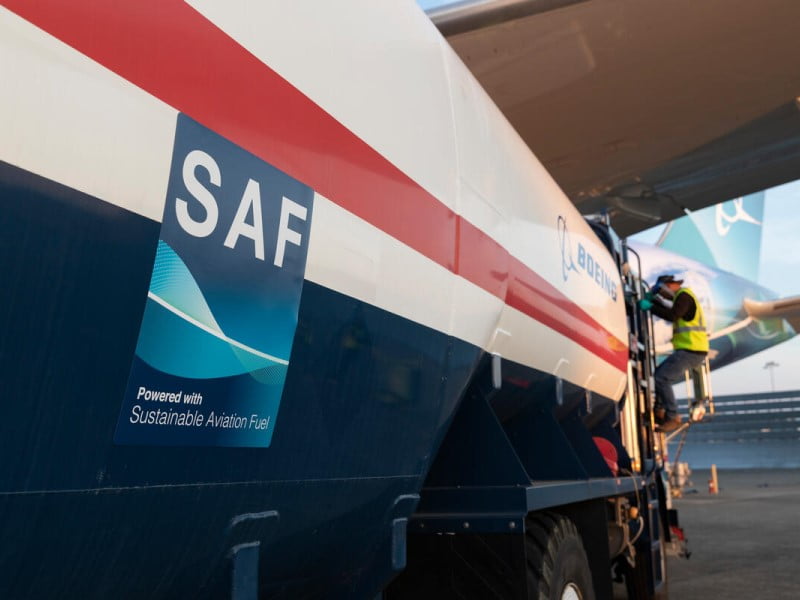A new roadmap highlighting the opportunities that will flow from the creation of a sustainable aviation fuel industry in Australia has been released by national science agency CSIRO and Boeing.
Sustainable Aviation Fuels (SAF) are chemically similar to conventional jet fuel (CIF) but are produced from feedstocks that can be replenished. SAFs burn cleaner and have a higher energy density than CIF, according to the report.
Australia has huge potential to produce SAF by processing existing organic feedstocks such as sugarcane or even municipal solid waste over the next two years, the roadmap said. In the medium- to long-term, the roadmap flags opportunities to produce SAF from hydrogen and carbon dioxide.
Modelling in the report found that the SAF opportunity could be worth $19 billion by 2050 with sufficient public and private sector.
The country already produces and exports large amounts of oilseeds and sugar as well as processed animal fat and used cooking oil. Australia is a major exporter of canola seed to the European Union, where it is processed into biofuels.
However, a current lack of economies of scale mean SAF can cost up to four times as much as CIF. Biogenic feedstocks also tend to have lower energy density and value density compared to crude fossil fuels. This means a larger volume of feedstock is needed to produce SAF compared to equivalent amount of CIF, adding to production costs.
Other barriers that need to be addressed include feedstock availability, supply chain constraints, and aligning with international standards and regulation.

Around 90 per cent of liquid fuels are imported, meaning sustainable aviation fuels are only available on flights that land at international airports where the products are already available. The domestic industry roadmap was released alongside a separate overview of SAF activity in other countries in the Asia Pacific.
Globally, aviation accounts for 2.5 per cent of greenhouse gas emissions. The report cites figures from the International Aviation Organisation that state SAFs can reduce fuel life cycle emissions between 60-100 per cent when compared to CIFs.
The roadmap includes five short-term (to 2025) recommendations, three medium term recommendations (2025-2035), and one long term (2035+) recommendation.
CSIRO senior manager and lead Roadmap Author Max Temminghoff said Australia’s existing economy is ripe for the development of a SAF industry.
“By actively working to liberate feedstocks, the roadmap estimates that Australia is currently sitting on enough resources to produce almost five billion litres of SAF by 2025. This could supply nearly 60 per cent of jet fuel demand projected for that year,” Mr Temminghoff said.
“That’s enough fuel to power 640,000 Melbourne to Sydney return flights on a Boeing 737.
“Through a combination of feedstocks and mature technologies, a large and growing portion of Australia’s jet fuel demand can be met with local materials such as agricultural waste and residues.
“To convert these feedstocks into viable jet fuel, the report identifies the Alcohol-to-Jet and the Fischer-Tropsch process – a process currently conducted at CSIRO’s Perth laboratory – as ideal technology options to propel a sovereign SAF industry.”
Boeing regional sustainability lead APAC and roadmap co-author Heidi Hauf noted that the report highlights a role for the Australian Defence Force “in kickstarting Australia’s SAF industry” to address fuel security challenges.
The federal government finalised the terms of reference and membership of its Jet Zero Council in June. It has three objective to drive decarbonisation of the aviation industry, including to “promote, mobilise, and galvanise industry efforts”.
Boeing sits on the Jet Zero Council as a manufacturing representative while CSIRO is the research and development representative.
Editor’s note: This story has been edited for clarity.
Do you know more? Contact James Riley via Email.


Interesting article, but a couple of points I wasn’t sure about.
In paragraph 2 the report is cited as saying SAFs have a higher energy density than CIF. But in a later paragraph it is stated that biogenic feedstocks tend to have lower energy density compared to crude fossil fuels. Those two statements seemed to me to be at odds with each other.
Second, it is mentioned that the report cites figures that state SAFs can reduce fuel life cycle emissions between 60-100 per cent when compared to CIFs. Probably I’m missing something, but wouldn’t reducing emissions by 100 per cent mean there would be zero emissions?
Any clarification would be appreciated!